
Upper Sturt Primary in South Australia used to be an ordinary state primary school. Since September 2015, the school has been predominantly an outdoor and nature-based school. The children are outside almost all the time, all year round. Whilst I plan to blog about the nature of the curriculum, in this post, I’m focusing on the outdoor environment. Regardless of what climate and country you live in, I hope this will provide good inspiration that change is possible.
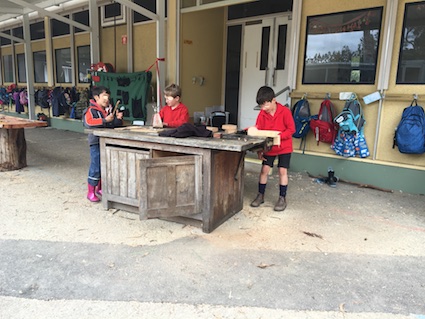
The above two photos were taken in September 2016, one year after the school “went bush”. As you can see, the playground is a fairly standard affair. There’s a bit of space for traditional sports activities. Some raised beds now occupy the centre. Under the shelter there’s a couple of changes. Firstly, there is a raised fire pit which is used for cooking. Not far from here, used to be the woodworking area. The children were free to access this in lessons or at play time. The boys in the photo are working away during their break. The tools are stored in the cupboards below and in the Mindstretchers Tree Wrap hanging up in the background.
When I returned in June 2018, the wood working area has been expanded and moved onto the playing field. Below you can see the old bench. Tools and more equipment are stored in the more spacious shed behind.
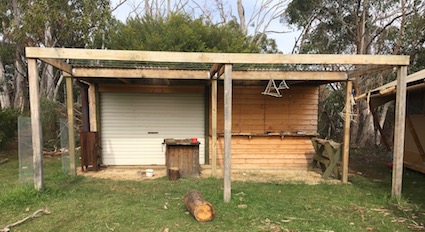
One interesting feature of outdoor schools and nurseries is the lost property. Many have a clothes line so that parents collecting their children or the children themselves know where to look for lost items. When children are outside more, it seems there are more places for clothing and footwear to be left. So be prepared for this, should you begin to make the outdoor shift in practice. As you can see, there is a school uniform – a common feature of Australian schools.
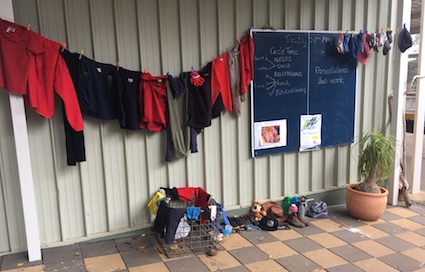
Upper Sturt Primary is unusual in that is is surrounded by bush (woodland) both on and off-site. So much of the school grounds is woodland. However, during play times, I noticed that children mainly stuck to the playing field, paths and playground and places on the periphery to these areas rather than wandering into the bush.

Throughout the bush there were traces of children’s play and learning. For example, I stumbled across this array of miniature dens built from bark. I noticed several break out places for classes to gather informally.
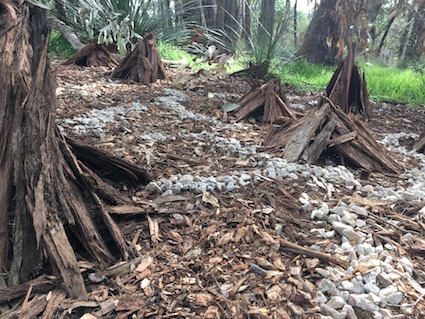
What is apparent is that for children, there is LOADS to do at playtimes. Aside from having the freedom to be wherever they wish, there are lots of play features scattered around. Below is a much-loved mud kitchen.
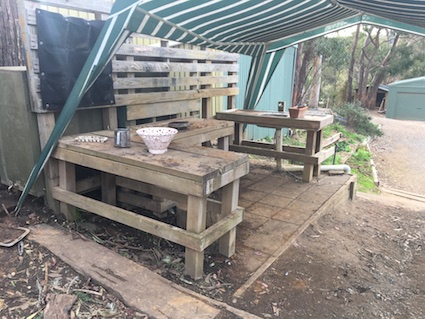
I spotted at least three swings of different sorts around the grounds. These were popular with children of all ages. Below, Lewis, who gave me a personal guided tour of the school, is demonstrating how to use the standing swing.
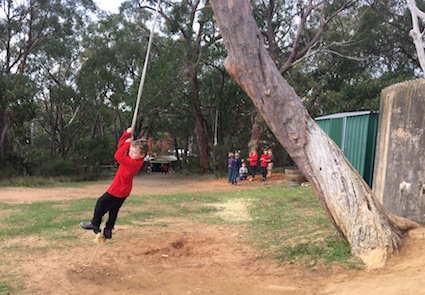
The garden area is continuing to change, grow and improve. There were more pockets of gardening around the school but this is part of the ‘Food Forest’ area. In a school where outdoor learning is valued, I often see gardening practice that is embedded into the life of the school. It is not a bolt on gardening club activity, rather something that all children get to access and enjoy. In the background you can see a large hen coop.
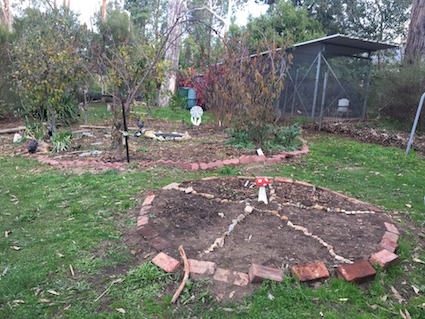
One of my favourite gardening books for schools is Australian, Outdoor Classrooms: A Handbook for School Gardens. This puts gardening in the context of learning, play and uses Permaculture ethics and principles.
The parts of the grounds where you enter as a visitor are the ones that still look most like a standard primary school. There’s the shade sails, seating areas and so on. In the distance you can see the office building and one of the classrooms.
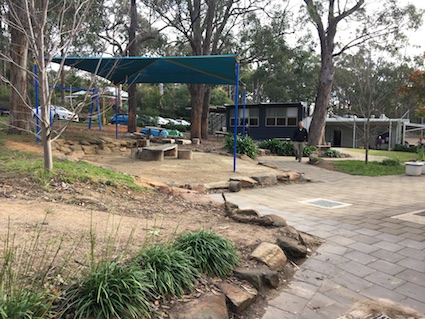
The stone ampitheatre is a popular teaching space, especially for the oldest class (Years 6 and 7 in England, P7 and S1 in Scotland). You can see an example of this happening in the BIO Learning blog post. Their indoor space is the building with the terrace. I loved that children were able to work where they chose – inside, outside on the deck or at the stone amphitheatre. Again, many teachers offer this choice, but perhaps not as consistently as I’ve seen here at Upper Sturt.
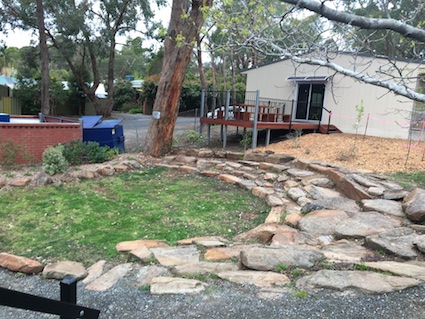
Below is an example of the indoor classroom of the kindergarten class (5 and 6yr olds). As you can see, there’s still a few tables and chairs but the space feels more empty than many. It is not neglected though. There are displays of children’s work on the walls and it has a busy hum about it.
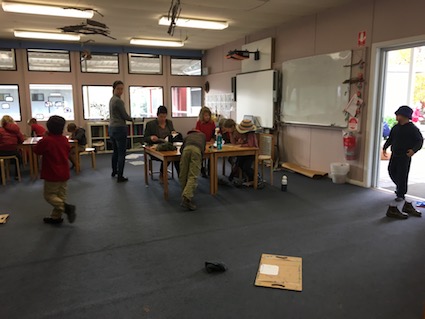
One aspect of outdoor schools and nurseries that is noticeable are changes. The grounds are constantly evolving in line with the children’s interests and projects that are happening. For me it is a key indicator that a school values its outdoor spaces when you see ongoing changes happening. Below an earth bag seat is being created.

Another new construction was the appearance of a platform at the edge of the playing field. It’s a stage for children’s imaginative plays, role plays and even small productions. In due course, it will even feature curtains.
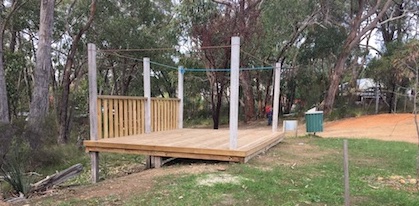
Part of the evolution that also seems to be common to schools that value outdoor learning and play, is the changing use and function of their playing field. Many realise that a flat green desert used mainly for sports games could be better utilised by the addition of various features. A large sandpit is a common development. Here at Upper Sturt, you can see one of two sand pits, surrounded by a plethora of natural loose parts.
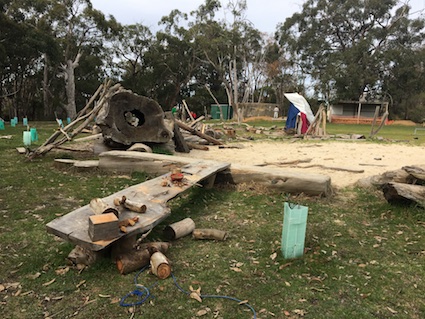
An informal pathway linking the tipi to the new outdoor classroom is also in the process of being created. I’m not sure if this a planned development or a play development being organised by the children. The green objects all house young trees. This also seems to happen when a school develops its outdoor space. Somehow a school or nursery can never have enough trees.
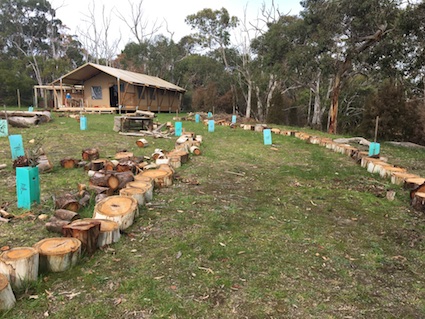
When I first visited Upper Sturt, the tipi was a new feature. Along with the other photos you can see that suddenly the playing field is being very well-used and is much-loved all year round.
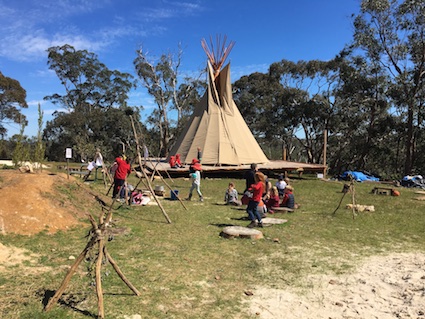
The other big feature on the playing field is the gathering space with a large fire pit in the centre. This is where each day begins.
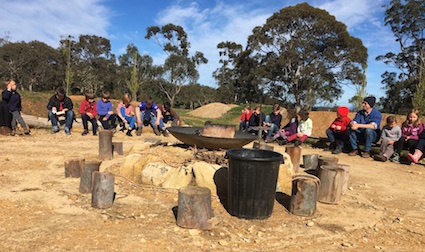
I hope this tour of Upper Sturt gives you a flavour of the school’s grounds. The questions below are what springs to mind in terms of reflecting on the need for a useful, interesting diverse learning space:
- How do your school grounds represent your school’s vision and values?
- Is it a constantly evolving space that reflects the children needs and interests?
- Who drives the changes and why?
- Are your grounds fit for purpose and suitable for a broad diversity of learning, play and wildlife?
- Are your grounds contributing to wider climate resilience within your local community?
- Does your outdoor practice take full account of indigenous and/or local cultures?
For inspiration, ideas and advice, check out the other blog posts about school grounds and outdoor spaces. Also check out this video of the Community Hub at Upper Sturt.
This blog post was originally published in August 2018. There has been a change of headship at the school since this blog post was published and so this is a snapshot in time rather than necessarily reflecting current practice.






























I would love to set up something like this here in Wales but would like to know how they teach all of the curriculum outdoors. I do lots of Outdoor learning but some things just seem impossible to do outdoors everyday.
Hi Andrea. You ask a very good question. The school is not 100% outside. The teachers make great use of their outdoor space, but when a classroom is needed, then it’s used. Also with outdoor schools and nurseries, a lot of material is not outdoor specific but the children work outside anyway.
I think there has been a lot of confusion in recent years within the UK about what constitutes outdoor learning. The outdoor schools and nurseries keep this simple: they just work outside and don’t get bound up with anything more complicated as a definition. In education, our focus needs to be kept on what makes an excellent outdoor experience. Sometimes, it is sufficient to simply be outside and reap the benefits of the fresh air, exercise and so on.
At Upper Sturt, the approach is child-centred but this does not preclude taught sessions such as the BIO learning blog indicates. Most importantly the staff have formed strong positive relationships with the children.